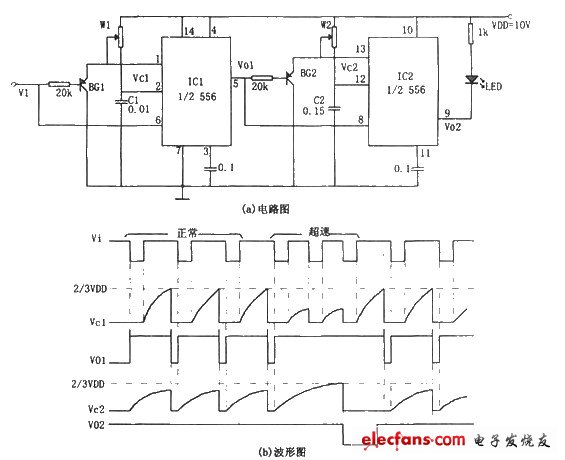The circuit consists of a dual time base integrated circuit 556 and some RC components. The negative polarity pulse from the speed sensor head is applied to the trigger terminal 6 of IC1 and the base of transistor BG1, turning BG1 on and setting IC1. The corresponding output (5 feet) is high. During the negative pulse, capacitor C1 is not charged, and C1 is charged after the negative pulse.
At normal speed, due to the long pulse interval, the charging voltage on C1 reaches 2/3 VDD before the next pulse arrives, so the IC1 circuit automatically flips and the 5 pin outputs a low level. When the speed exceeds the normal value, the input pulse interval becomes shorter, and the voltage on the corresponding C1 has not reached 2/3 VDD. C1 is discharged through the conduction tube BG1, and the IC1 circuit is set to continue to output a high level.
The operation of the IC2 monostable flip-flop is the same as that of IC1, except that it is controlled by the output of IC1, and the charging time constant of IC2 (1.1Rw2C2) is greater than the period of input pulse of Vo1 at normal speed, so at normal speed, C2 The charging voltage is lower than 2/3VDD, and IC2 outputs a high level. When overspeed, since Vo1 continues to be high, the voltage on C2 is charged to 2/3VDD, which causes IC2 to flip, reset, and output low. At this time, the LED emits light, indicating that the speed has been exceeded, that is, an alarm.

A close-up lens is a close-up attachment similar to a filter. Observing the scene alone is like a magnifying glass. Its front is raised for image amplification, while its back is slightly concave to reduce image field bending to a certain extent. The proximity lens has the advantages of simple structure and low price. During operation, there is no exposure compensation adjustment, and it can be used alone and in combination, which is very convenient.The proximity lens has the advantages of simple structure and low price. During operation, there is no exposure compensation adjustment, and it can be used alone and in combination, which is very convenient. In addition, in addition to being suitable for single lens reflex cameras, proximity lenses can also be used for side axis viewfinder cameras and dual lens reflex cameras. However, since the camera with separate viewfinder will have obvious parallax during close-up shooting, it is necessary to cooperate with the close-up viewfinder accessories in order to adjust the corresponding shooting angle.
The disadvantages of proximity lens are: Although the aberration is controlled to a certain extent, it can not be completely eliminated; When in use, it will slightly affect the clarity of photos; Focusing will be limited. After adding a proximity lens, you need to move the distance between the camera and the subject to focus.Close Up Filter,Close Up Lens Filter,Close Up Filter Set,Camera Close Up Filter
shaoxing shangyu Tianya Photographic Equipment Factory , https://www.tianyafoto.com
